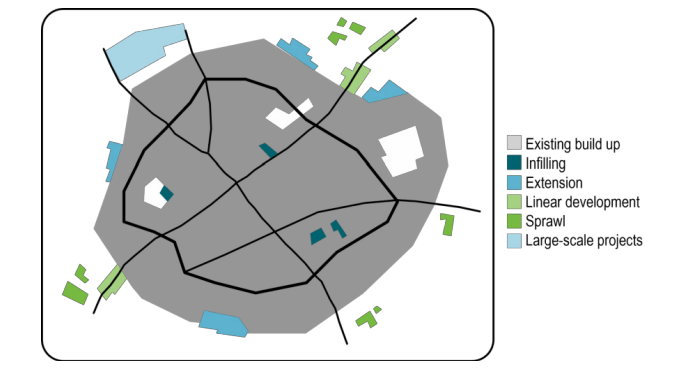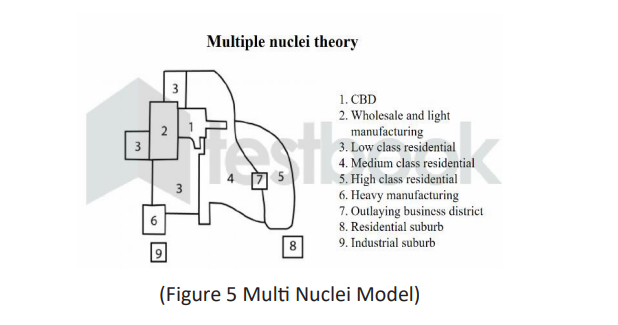
Urban sprawl around major cities is a complex phenomenon influenced by various interconnected drivers that shape the spatial expansion of urban areas. The factors contributing to this sprawling growth are multifaceted, encompassing demographic, economic, and policy-related elements. Population growth, increased demand for housing, and economic opportunities often drive the outward expansion of cities. Moreover, the role of transport infrastructure investments cannot be overlooked in this process. New investments in transport projects, while intended to enhance connectivity and accessibility, have inadvertently supported sprawl development by facilitating easier mobility to and from suburban areas. As transportation networks expand, it becomes more convenient for individuals to live farther away from city centers, contributing to the outward spread of urban landscapes. This interplay between demographic shifts, economic dynamics, and transportation investments plays a crucial role in the ongoing phenomenon of urban sprawl around major cities.
Contents
Answer
Urban sprawl is the unplanned, often low-density expansion of urban areas into surrounding undeveloped or rural land. Urban sprawl around major cities in a country can be driven by several factors.
Key drivers of urban sprawl around the major cities are as follows:
- Population Growth
- Leapfrogging
- Economic Opportunities
- Real Estate Development
- Government Policies
- Edge Cities
- Transport Nodes and Hubs
- Transportation-Induced Agglomeration
- Population Growth (Demographic Factor):
- As cities experience population growth, there is an increased demand for housing and services.
- Cities act as central places that provide goods and services. (Centre Place Theory)
- As cities grow and their populations increase, there is a need for additional settlements on the urban periphery to meet demand, contributing to sprawl.

- Leapfrogging is a concept that refers to the development of suburban areas beyond the immediate outskirts of the city.
- Transport investments can facilitate leapfrog development by making previously distant areas accessible for housing and commercial purposes.
- Economic Opportunities (Economic Factor)
- Economic activities and job opportunities often concentrate in urban cores.
People seeking employment may move to suburbs while maintaining a connection to job centres through transport networks.
- Real Estate Development (Land Use Factor):
- Developers often find it more cost-effective to purchase and develop land on the outskirts of cities, where land is cheaper and more readily available.
- This contributes to sprawl.
- Government Policies (Political Factor):
- Government policies, such as tax incentives for suburban development or investment in suburban infrastructure, can encourage sprawl.
- Edge Cities (Post modern urbanism)
- The concept of edge cities, which are large suburban areas with their own economic and cultural significance, can drive sprawl as these areas develop outside the urban core.
- • Transport Nodes and Hubs
- Transport projects that create nodes or hubs in suburban areas can act as magnets for development, fostering sprawl around these transport centres.
New investments in transport projects have supported sprawl development in following manner
- Hoyt’s Sector Model describes the growth of cities in sectors or corridors along transportation routes.

- Investment in transport projects can lead to the expansion of these corridors and facilitate urban sprawl along major transportation arteries
- For e.g. The growth of sectors along transportation corridors is evident in Chennai, where the Old Mahabalipuram Road (OMR) corridor has seen significant urban expansion.

- Multiple Nuclei Model (Harris and Ulman) explains that cities have multiple centres of activity.
- Investments in transport projects can create new nuclei or centres in the suburbs, leading to the growth of secondary urban areas.
- For e.g., Greater London’s multiple nuclei include Canary Wharf-become a major financial district outside the traditional city centre.
- Transportation-Induced Agglomeration
- New transport projects can stimulate economic activities in previously remote areas, leading to the development of new settlements and sprawl.
- For example, new highways can attract logistics and distribution centres.
- Investment in transport infrastructure in areas like Bengaluru’s International Airport region has spurred the development of an economic base, attracted IT companies and led to urban sprawlEconomic Base Theory (Perroux)
National Urban Policy (NUP), Smart Cities Mission, Transit-Oriented Development (TOD) Policy, Land Pooling Policy, Greenbelt Development are a step in right direction.
In case you still have your doubts, contact us on 9811333901.
For UPSC Prelims Resources, Click here
For Daily Updates and Study Material:
Join our Telegram Channel – Edukemy for IAS
- 1. Learn through Videos – here
- 2. Be Exam Ready by Practicing Daily MCQs – here
- 3. Daily Newsletter – Get all your Current Affairs Covered – here
- 4. Mains Answer Writing Practice – here

